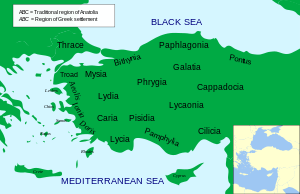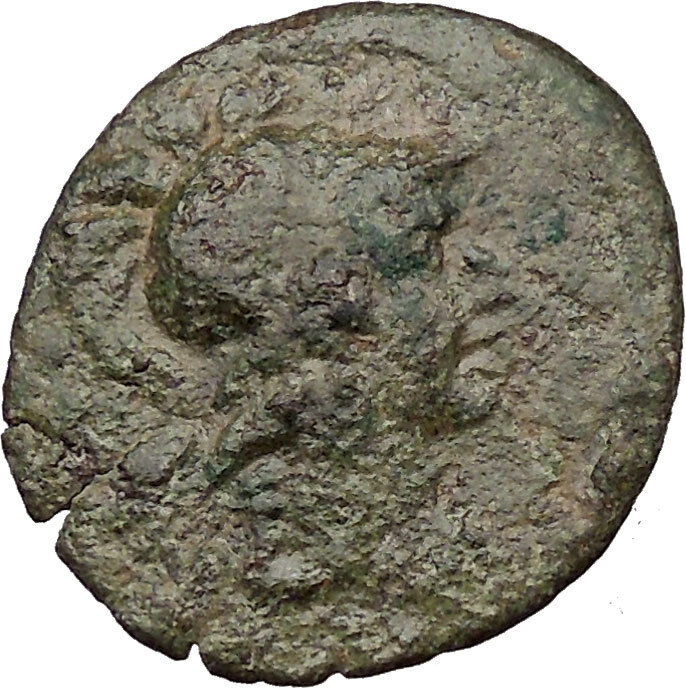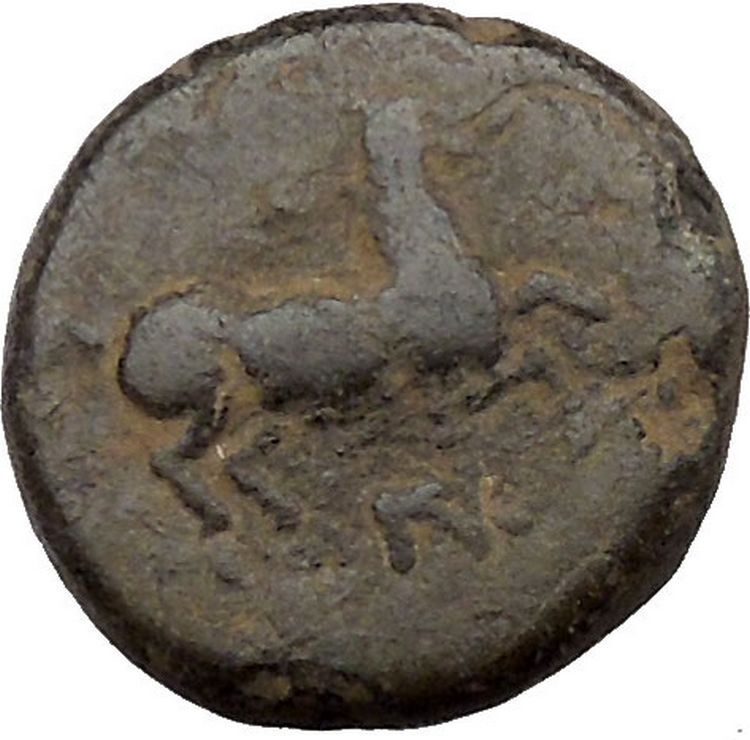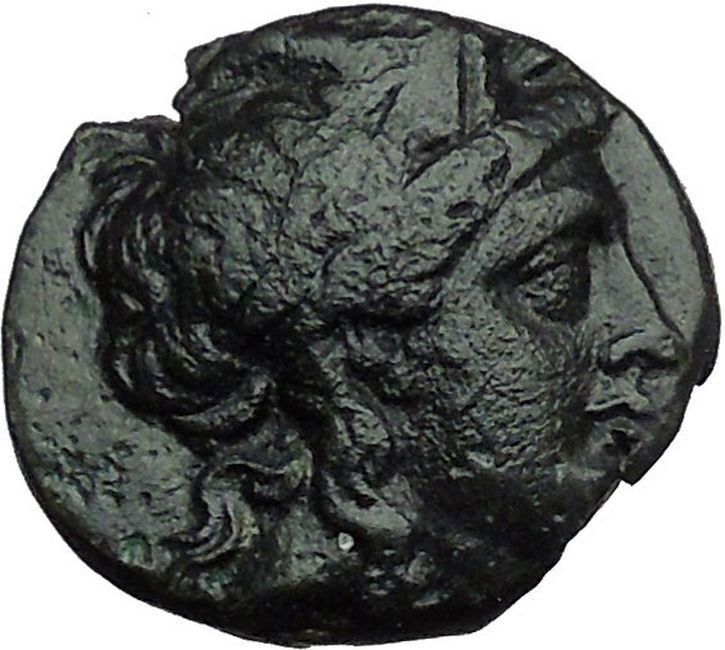
In
antiquity,
Phrygia was a kingdom in the west central part of
Anatolia
, in what is now
Turkey
, centered on the
Sakarya River
.
During the
heroic age
of
Greek mythology
, several legendary kings
were Phrygians
:
Gordias
whose
Gordian Knot
would later be cut by
Alexander the Great
,
Midas
who turned whatever he touched to
gold, and
Mygdon
who warred with the
Amazons
. According to
Homer
‘s
Iliad
, the Phrygians were close allies of
the Trojans
and participants in the
Trojan War
against the
Achaeans
. Phrygian power reached its peak
in the late 8th century BC under another, historical, king:
Midas
, who dominated most of western and
central Anatolia and rivaled
Assyria
and
Urartu
for power in eastern Anatolia. This
later Midas was, however, also the last independent king of Phrygia before
its capital Gordium
was sacked by
Cimmerians
around 695 BC. Phrygia then
became subject to
Lydia
, and then successively to
Persia
,
Alexander
and his
Hellenistic
successors,
Pergamon
,
Rome
and
Byzantium
. Phrygians were gradually
assimilated into other cultures by the early medieval era, and after the
Turkish
conquest of Anatolia the name
Phrygia passed out of usage as a territorial designation.
Geography
Phrygia describes an area on the western end of the high Anatolian
plateau, an arid region quite unlike the forested lands to the north and
west. Phrygia begins in the northwest where an area of dry steppe is watered
by the Sakarya and
Porsuk
river system and is home to the
settlements of
Dorylaeum
near modern
Eskisehir
, and the Phrygian capital
Gordion
. The climate is harsh with hot
summers and cold winters; olives will not easily grow here and the land is
mostly used for livestock grazing and the production of barley. South of
Dorylaeum, there is another important Phrygian settlement, Midas City (Yazılıkaya,
Eskişehir), situated in an area of hills and columns of volcanic
tufa
. To the south again, central Phrygia
includes the cities of
Afyonkarahisar
(ancient Akroinon) with its
marble quarries at nearby
Docimium
(İscehisar), and the town of
Synnada
. At the western end of Phrygia,
stood the towns of
Aizanoi
(modern
Çavdarhisar
) and
Acmonia
. From here to the southwest lies
the hilly area of Phrygia that contrasts to the bare plains of the region’s
heartland. Southwestern Phrygia is watered by the Maeander (Büyük
Menderes River) and its tributary the
Lycus
, and contains the towns of
Laodicea on the Lycus
and
Hierapolis
.
Origins
Inscriptions found at
Gordium
make clear that Phrygians spoke an
Indo-European
language with at least some
vocabulary similar to
Greek
, and clearly not belonging to the
family of
Anatolian languages
spoken by most of
Phrygia’s neighbors. One of the so-called
Homeric Hymns
describes the
Phrygian language
as not mutually
intelligible with that of Troy.
According to ancient tradition among Greek historians, the Phrygians
anciently migrated to
Anatolia
from the
Balkans
.
Herodotus
says the Phrygians were called
Bryges
when they lived in Europe. He and
other Greek writers also recorded legends about King
Midas
that associated him with or put his
origin in
Macedonia
; Herodotus, for example, says a
wild rose garden in Macedonia was named after Midas. Some classical writers
also connected the Phrygians with the
Mygdones
, the name of two groups of people,
one of which lived in northern Macedonia and another in
Mysia
. Likewise the
Phrygians
have been identified with the
Bebryces
, a people said to have warred with
Mysia
before the
Trojan War
and who had a king named
Mygdon
at roughly the same time as the
Phrygians were said to have had a king named Mygdon. The classical historian
Strabo
groups Phrygians,
Mygdones
,
Mysians
,
Bebryces
and
Bithynians
together as peoples that
migrated to Anatolia from the Balkans. This image of Phrygians as part of a
related group of northwest Anatolian cultures seems the most likely
explanation for the confusion over whether
Phrygians
,
Bebryces
and Anatolian Mygdones were or
were not the same people.
The apparent similarity of the
Phrygian language
to Greek and its
dissimilarity with the
Anatolian languages
spoken by most of their
neighbors is also taken as support for a European origin of the Phrygians.
Phrygian continued to be spoken until sixth century AD, though its
distinctive alphabet was lost earlier than those of most Anatolian cultures.
Some scholars have theorized that such a migration could have occurred
more recently than classical sources suggest, and have sought to fit the
Phrygian arrival into a narrative explaining the downfall of the
Hittite Empire
and the end of the high
Bronze Age in Anatolia. According to this “recent migration” theory, the
Phrygians invaded just before or after the collapse of the Hittite Empire at
the beginning of the 12th century BC, filling the political vacuum in
central-western Anatolia, and may have been counted among the “Sea
Peoples” that Egyptian records credit with bringing about the
Hittite collapse. The so-called Handmade Knobbed Ware found in Western
Anatolia during this period has been tentatively identified as an import
connected to this invasion.
However, most scholars reject such a recent Phrygian migration and accept
as factual the
Iliad
‘s account that the Phrygians were
established on the
Sakarya River
before the
Trojan War
, and thus must have been there
during the later stages of the
Hittite Empire
, and probably earlier. These
scholars seek instead to trace the Phrygians’ origins among the many nations
of western Anatolia who were subject to the
Hittites
. This interpretation also gets
support from Greek legends about the founding of Phrygia’s main city
Gordium
by
Gordias
and of
Ancyra
by
Midas
, which suggest that Gordium and
Ancyra were believed to be date from the distant past before the Trojan War.
Some scholars dismiss the claim of a Phrygian migration as a mere legend,
likely arising from the coincidental similarity of their name to the
Bryges
.
No one has conclusively identified which of the many subjects of the
Hittites
might have represented early
Phrygians. According to a classical tradition, popularized by
Josephus
, Phrygia can be equated with the
country called
Togarmah
by the ancient Hebrews, which has
in turn been identified as the
Tegarama
of Hittite texts and Til-Garimmu
of Assyrian records.
Josephus
called Togarmah “the Thrugrammeans,
who, as the Greeks resolved, were named Phrygians”. However, the Greek
source cited by
Josephus
is unknown, and it is unclear if
there was any basis for the identification other than name similarity.
Scholars of the Hittites believe Tegarama was in eastern Anatolia – some
locate it at Gurun
– far to the east of Phrygia. Some
scholars have identified Phrygia with the
Assuwa
league, and noted that the
Iliad
mentions a Phrygian (Queen
Hecuba
‘s brother) named
Asios
. Another possible early name of
Phrygia could be Hapalla, the name of the easternmost province that emerged
from the splintering of the Bronze Age western Anatolian empire
Arzawa
. However, scholars are unsure if
Hapalla corresponds to Phrygia or to
Pisidia
, further south.
Herodotus
also claims that Phrygian
colonists founded the
Armenian
nation. This is likely a reference
to a third group of people called
Mygdones
living in northern
Mesopotamia
who were apparently allied to
the Armenians;
Xenophon
describes them in his
Anabasis
in a joint army with the
Armenians
. However, little is known about
these eastern Mygdones, and no evidence of
Phrygian language
in that region has been
found.
Eric P. Hamp
in his 2012
Indo-European
family tree classified the
Phrygian language
together with
Italo-Celtic
as member of a member of a “Northwest Indo-European” group. In Hamp’s view,
Northwest Indo-Europeans are likely to have been the first inhabitants of
Hallstatt
with the Pre-Phrygians moving
east and south to Anatolia in the same manner as the Galatians do later.
Raymund Carl in 2010 mentions that the
Lausitz culture
was one such Hallstatt-associated culture.
History
Around
the time of the Trojan war
According to the Iliad, the homeland of the Phrygians was on the
Sangarius River
,
which would remain the centre of Phrygia throughout its history. Phrygia was
famous for its wine and had “brave and expert” horsemen.
According to the
Iliad
, before the
Trojan War
, a young king
Priam
of
Troy
had taken an army to Phrygia to
support it in a war against the
Amazons
. Homer calls the Phrygians “the
people of
Otreus
and godlike
Mygdon
. According to
Euripides
,
Quintus Smyrnaeus
and others, this Mygdon’s
son, Coroebus
, fought and died in the
Trojan War
; he had sued for the hand of the
Trojan princess
Cassandra
in marriage. The name Otreus
could be an eponym for
Otroea
, a place on
Lake Ascania
in the vicinity of the later
Nicaea
, and the name Mygdon is
clearly an eponym for the
Mygdones
, a people said by
Strabo
to live in northwest Asia Minor, and
who appear to have sometimes been considered distinct from the
Phrygians
. However,
Pausanias
believed that Mygdon’s tomb was
located at
Stectorium
in the southern Phrygian
highlands, near modern
Sandikli
.
According to the
Bibliotheca
, the Greek hero
Heracles
slew a king Mygdon of the
Bebryces
in a battle in northwest Anatolia
that if historical would have taken place about a generation before the
Trojan War
. According to the story, while
traveling from Minoa
to the
Amazons
, Heracles stopped in
Mysia
and supported the
Mysians
in a battle with the Bebryces.
According to some interpretations, Bebryces is an alternate name for
Phrygians and this Mygdon is the same person mentioned in the
Iliad
.
King Priam
married the Phrygian princess Hecabe
(or Hecuba
) and maintained a close alliance
with the Phrygians, who repaid him by fighting “ardently” in the
Trojan War
against the Greeks. Hecabe was a
daughter of the Phrygian king
Dymas
, son of Eioneus, son of Proteus.
According to the Iliad
, Hecabe’s younger brother
Asius
also fought at Troy (see above); and
Quintus Smyrnaeus
mentions two grandsons of
Dymas that fell at the hands of
Neoptolemus
at the end of the Trojan War:
“Two sons he slew of Meges rich in gold, Scion of Dymas – sons of high
renown, cunning to hurl the dart, to drive the steed in war, and deftly cast
the lance afar, born at one birth beside Sangarius’ banks of Periboea to
him, Celtus one, and Eubius the other.”
Teleutas
, father of the maiden
Tecmessa
, is mentioned as another mythical
Phrygian king.
There are indications in the Iliad that the heart of the Phrygian country
was further north and downriver than it would be in later history. The
Phrygian contingent arrives to aid
Troy
Phorcys and
Ascanius
, both sons of Aretaon.
In one of the so-called
Homeric Hymns
, Phrygia is said to be “rich
in fortresses” and ruled by “famous
Otreus
“.
Peak and destruction of the Phrygian kingdom
Detail from a reconstruction of a Phrygian building at Pararli,
Turkey, 7th–6th Centuries BC; Museum of Anatolian Civilizations,
Ankara
. A griffin, sphinx and
two centaurs are shown.
During the 8th century BC the Phrygian kingdom with its capital at
Gordium
in the upper
Sakarya River
valley expanded into an empire dominating most of central and western
Anatolia and encroaching upon the larger
Assyrian Empire
to its southeast and the
kingdom of Urartu
to the northeast.
According to the classical historians
Strabo
,
Eusebius
and
Julius Africanus
, the king of Phrygia
during this time was another
Midas
. This historical
Midas
is believed to be the same person
named as Mita in Assyrian texts from the period and identified as king of
the Mushki
. Scholars figure that Assyrians
called Phrygians “Mushki” because the Phrygians and
Mushki
, an eastern Anatolian people, were
at that time campaigning in a joint army. This Midas is thought to have
reigned Phrygia at the peak of its power from about 720 BC to about 695 BC
(according to Eusebius) or 676 BC (according to Julius Africanus). An
Assyrian inscription mentioning “Mita”, dated to 709 BC, during the reign of
Sargon of Assyria
, suggests Phrygia and
Assyria
had struck a truce by that time.
This Midas
appears to have had good relations
and close trade ties with the Greeks, and reputedly married an Aeolian Greek
princess.
A system of writing in the
Phrygian language
developed and flourished
in Gordium during this period, using a Phoenician-derived alphabet similar
to the Greek one. A distinctive Phrygian pottery called Polished Ware
appears during this period.
However, the Phrygian Kingdom was then overwhelmed by
Cimmerian
invaders, and
Gordium
was sacked and destroyed. According
to Strabo and others,
Midass
Tomb at
Midas
City (6th century BC),
near
Eskişehir
A series of digs have opened
Gordium
as one of Turkey’s most revealing
archeological sites. Excavations confirm a violent destruction of Gordium
around 675 BC. A tomb from the period, popularly identified as the “Tomb of
Midas,” revealed a wooden structure deeply buried under a vast
tumulus
, containing grave goods, a coffin,
furniture, and food offerings (Archaeological Museum, Ankara).
As a Lydian province
After their destruction of
Gordium
, the Cimmerians remained in western
Anatolia and warred with
Lydia
, which eventually expelled them by
around 620 BC, and then expanded to incorporate Phrygia, which became the
Lydian empire’s eastern frontier. The Gordium site reveals a considerable
building program during the 6th century BC, under the domination of Lydian
kings including the proverbially rich King
Croesus
. Meanwhile, Phrygia’s former
eastern subjects fell to
Assyria
and later to the
Medes
.
There may be an echo of strife with Lydia and perhaps a veiled reference
to royal hostages, in the legend of the twice-unlucky Phrygian prince
Adrastus
, who accidentally killed his
brother and exiled himself to
Lydia
, where King
Croesus
welcomed him. Once again, Adrastus
accidentally killed Croesus’ son and then committed suicide.
As Persian
province(s)
Achaemenid (Great
Persian) Empire when
Cyrus
conquered
Lydia
.
After Darius became Persian Emperor in 521 BC, he remade the ancient
trade route into the Persian “Royal
Road” and instituted administrative reforms that included setting
up
satrapies
. The Phrygian
satrapy
(province) lay west of the
Halys River
(now
Kızıl River
)
and east of Mysia
and Lydia. Its capital was
established at
Dascylium
, modern
Ergili
.
In the course of the 5th century, the region was divided in two
administrative satrapies :
Hellespontine Phrygia
and Greater Phrygia.
Under
Alexander and his successors
Alexander the Great
passed through
Gordium
in 333 BC and severed the
Gordian Knot
in the temple of
Sabazios
(“Zeus“).
According to a legend, possibly promulgated by Alexander’s publicists,
whoever untied the knot would be master of
Asia
. With Gordium sited on the
Persian Royal Road
that led through the
heart of Anatolia
, the prophecy had some
geographical plausibility. With Alexander, Phrygia became part of the wider
Hellenistic
world. Upon Alexander’s death
in 323, the
Battle of Ipsus
took place in 301 BC.
In the chaotic period after Alexander’s death, northern Phrygia was
overrun by Celts
, eventually to become the province of
Galatia
. The former capital of
Gordium
was captured and destroyed by the
Gauls soon afterwards and disappeared from history. In 188 BC, the southern
remnant of Phrygia came under the control of the
Attalids
of
Pergamon
. However, the
Phrygian language
survived, now written in
the
Greek alphabet
.
The two Phrygian provinces within the Diocese of Asia, c. 400 AD
In 133 BC, the remnants of Phrygia passed to
Rome
. For purposes of provincial
administration the Romans maintained a divided Phrygia, attaching the
northeastern part to the province of
Galatia
and the western portion to the
province of
Asia
. During the reforms of
Diocese of Asia
Diocletian
. Salutaris with Synnada as
its capital comprised the eastern portion of the region and Pacatiana with
Laodicea on the Lycus
as capital the
western portion. The provinces survived up to the end of the 7th century,
when they were replaced by the
Theme system
. In the
Byzantine
period, most of Phrygia belonged
to the
Anatolic theme
.
It was overrun by the Turks in the aftermath of the
Battle of Manzikert
(1071). The Byzantines
were finally evicted from there in the 13th century, but the name of
Phrygia remained in use until the collapse of the Byzantine Empire in
1453.
Culture
The ruins of Gordion and Midas City prove that Phrygia had developed an
advanced
Bronze Age
culture. This Phrygian culture
interacted in a number of ways with Greek culture in various periods of
history.
The “Great Mother”,
Cybele
, as the Greeks and Romans knew her,
was originally worshiped in the
mountains
of Phrygia, where she was known
as “Mountain Mother”. In her typical Phrygian form, she wears a long belted
dress, a polos (a high cylindrical headdress), and a veil covering
the whole body. The later version of Cybele was established by a pupil of
Phidias
, the
sculptor
Agoracritus
, and became the image most
widely adopted by Cybele’s expanding following, both in the
Aegean
world and at
Rome
. It shows her humanized though still
enthroned, her hand resting on an attendant lion and the other holding the
tympanon
, a circular frame drum,
similar to a
tambourine
.
The Phrygians also venerated
Sabazios
, the sky and father-god
depicted on horseback. Although the Greeks associated Sabazios with
Zeus
, representations of him, even at Roman
times, show him as a horseman god. His conflicts with the indigenous Mother
Goddess, whose creature was the
Lunar Bull
, may be surmised in the way that
Sabazios’ horse places a hoof on the head of a bull, in a
Roman relief
at the
Museum of Fine Arts, Boston
.
The earliest traditions of
Greek music
derived from Phrygia,
transmitted through the Greek colonies in Anatolia, and included the
Phrygian mode
, which was considered to be
the warlike mode in ancient Greek music. Phrygian
Midas
, the king of the “golden touch”, was
tutored in music by
Orpheus
himself, according to the myth.
Another musical invention that came from Phrygia was the
aulos
, a reed instrument with two pipes.
Marsyas
, the
satyr
who first formed the instrument using
the hollowed antler
of a
stag
, was a Phrygian follower of Cybele. He
unwisely competed in music with the
Olympian
Apollo
and inevitably lost, whereupon
Apollo flayed Marsyas alive and provocatively hung his skin on Cybele’s own
sacred tree, a pine
.
Classical Greek iconography identifies the
Trojan
Paris
as non-Greek by his Phrygian cap,
which was worn by
Mithras
and survived into modern imagery as
the “Liberty
cap” of the American and
French revolutionaries
. The Phrygians spoke
an
Indo-European language
. (See
Phrygian language
.) Although the
Phrygians adopted the
alphabet
originated by the
Phoenicians
, only a few dozen inscriptions
in the Phrygian language have been found, primarily funereal, and so much of
what is thought to be known of Phrygia is second-hand information from Greek
sources.
Mythic past
Tantalus who ruled over the north western
region of Phrygia around
Mount Sipylus
. Tantalus was endlessly
punished in
Tartarus
, because he allegedly killed his
son Pelops
and sacrificially offered him to the
Olympians, a reference to the suppression of
human sacrifice
. Tantalus was also falsely
accused of stealing from the lotteries he had invented. In the mythic age
before the
Trojan war
, during a time of an
interregnum
,
Gordius
(or Gordias), a Phrygian farmer,
became king, fulfilling an oracular
prophecy
. The kingless Phrygians had turned
for guidance to the oracle of Sabazios (“Zeus” to the Greeks) at
Telmissus
, in the part of Phrygia that
later became part of
Galatia
. They had been instructed by the
oracle to acclaim as their king the first man who rode up to the god’s
temple in a cart. That man was Gordias (Gordios, Gordius), a farmer, who
dedicated the ox-cart in question, tied to its shaft with the “Gordian
Knot“. Gordias refounded a capital at Gordium in west central
Anatolia, situated on the old trackway through the heart of Anatolia that
became
Darius
‘s Persian “Royal Road” from
Pessinus
to
Ancyra
, and not far from the
River Sangarius
.
Man in Phrygian costume,
Hellenistic
period (3rd–1st
century BC),
Cyprus
The Phrygians are associated in Greek mythology with the
Dactyls
, minor gods credited with the
invention of iron smelting, who in most versions of the legend lived at
Mount Ida
in Phrygia.
Gordias
‘s son (adopted in some versions)
was Midas
. A large body of myths and legends
surround this first king Midas. connecting him with a mythological tale
concerning Attis
. This shadowy figure resided at
Pessinus and attempted to marry his daughter to the young Attis in spite of
the opposition of his lover Agdestis and his mother, the goddess
Cybele
. When Agdestis and/or Cybele appear
and cast madness upon the members of the wedding feast. Midas is said to
have died in the ensuing chaos.
King Midas is said to have associated himself with
Silenus
and other satyrs and with
Dionysus
, who granted him a “golden touch”.
In one version of his story, Midas travels from Thrace accompanied by a
band of his people to Asia Minor to wash away the taint of his unwelcome
“golden touch” in the river
Pactolus
. Leaving the gold in the river’s
sands, Midas found himself in Phrygia, where he was adopted by the childless
king Gordias and taken under the protection of Cybele. Acting as the visible
representative of Cybele, and under her authority, it would seem, a Phrygian
king could designate his successor.
The Phrygian Sibyl
was the priestess presiding over the
Apollonian oracle
at Phrygia.
According to
Herodotus
, the Egyptian pharaoh
Psammetichus II
had two children raised in isolation in order to find the original language.
The children were reported to have uttered bekos which is Phrygian
for “bread”, so Psammetichus admitted that the Phrygians were a nation older
than the Egyptians.
Christian Phrygia
Visitors from Phrygia were reported to have been among the crowds present
in Jerusalem
on the occasion of
Pentecost
as recorded in
Acts 2:10
. In
Acts 16:6
the
Apostle Paul
and his companion
Silas
travelled through Phrygia and the
region of Galatia
proclaiming the
Christian gospel
. Their plans appear to
have been to go to
Asia
but circumstances or guidance, “in
ways which we are not told, by inner promptings, or by visions of the night,
or by the inspired utterances of those among their converts who had received
the gift of prophecy” prevented them from doing so and instead they
travelled westwards towards the coast.
Montanism, and still known in
Orthodoxy
as “the Phrygian heresy”, arose
in the unidentified village of Ardabau in the second century AD, and was
distinguished by ecstatic spirituality and women priests. Originally
described as a rural movement, it is now thought to have been of urban
origin like other Christian developments. The new Jerusalem its adherents
founded in the village of Pepouza has now been identified in a remote valley
that later held a monastery.





![Asclepius with his serpent-entwined staff[1]](https://upload.wikimedia.org/wikipedia/commons/thumb/9/97/Statue_of_Asklepios_NAMA_263_(DerHexer).JPG/200px-Statue_of_Asklepios_NAMA_263_(DerHexer).JPG)
 Asclepius
Asclepius 










